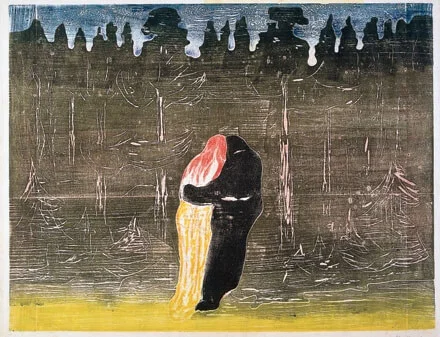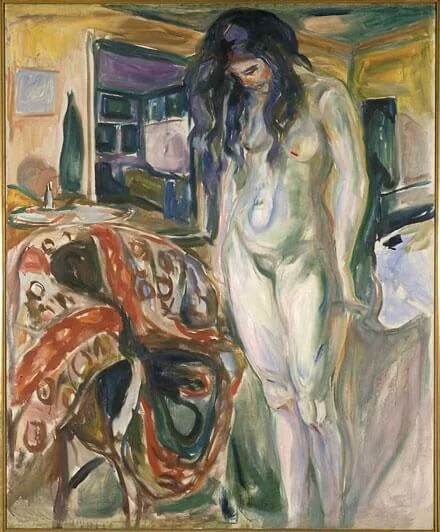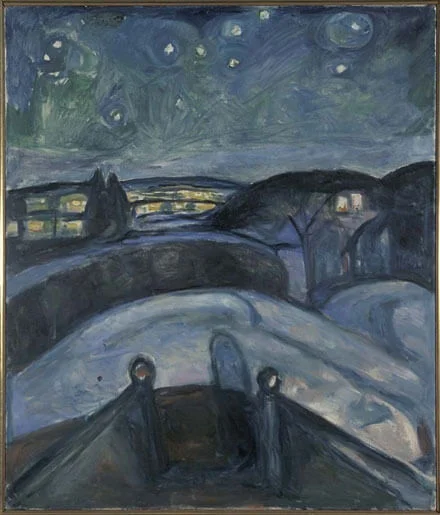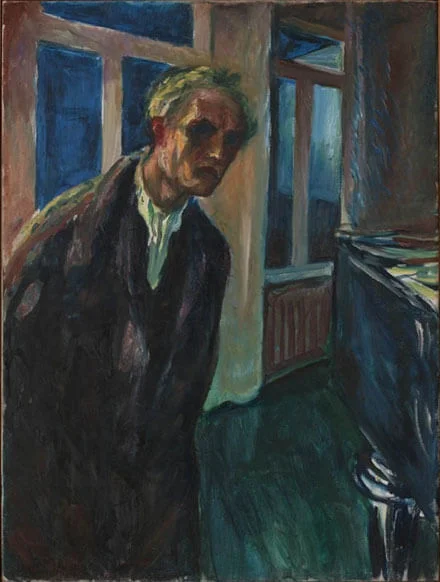Biography of Munch
(December 12, 1863)
Norway and Oslo
Munch’s delicate mental and physical health continued to decline, aggravated by nicotine poisoning and excessive alcohol consumption. In 1908, he entered the Copenhagen, Denmark sanatorium of Dr. Daniel Jacobsen, where he remained for eight months seeking relief of his self-diagnosed “nerve crisis.” During this period of recuperation, he continued producing portraits and arranged sales to Norwegian collectors. He also arranged a retrospective exhibition in Kristiania.

Towards the Forest II. 1915, Woodcut with Gouges, 50.4x647cm, Munch Museet
Upon his release from the clinic, Munch relocated to Kragerø on the southern Norwegian coast. In the midst of World War I, and isolated from his patrons in Germany, Munch found a receptive Norwegian audience. Industrialists and ship owners who were enjoying new-found wealth from Norway’s wartime neutrality became his source of commissions and funding. In 1915 he collected autobiographical material and augmented it with selected drawings and prints, producing a bound portfolio he called The Tree of the Knowledge of Good and Evil. He also reworked paintings and motifs of the 1890s and early 1900s. He entered a competition for the commission of wall paintings for the newly-constructed University Aula in Kristiania. Munch received the commission; and the paintings, the most important of which were History, Alma Mater and The Sun, were finally installed in The University’s Great Hall (The Aula) in 1916.

Model by Wicker Chair, 1919-1921, Oil on Canvas, 112.5x100cm, Munch Museet
That year, Munch bought a home in Ekely, where he lived out his remaining days. The effect Munch had on German contemporary art was becoming recognized and acknowledged, and in 1917 Curt Glaser published the biography Edvard Munch inBerlin. The early 1920s were prolific for Munch, who traveled to Berlin, Paris, Wiesbaden, and Frankfurt. He exhibited in Switzerland and Germany, where he was now accepted as a member of the Kunstakademien of Prussia and Bavaria.

Starry Night. 1922-1924, Oil on Canvas, 140x119cm, Munch Museet
In 1926, Much’s sister Laura died, and he became more and more withdrawn. While he appeared to significantly withdraw from the art world, his paintings reflected a feeling of homecoming and feature Norwegian landscapes.
Munch celebrated his 70th birthday in 1933. The following years proved less profitable. His art was removed from German museums, and opportunities for exhibition decreased dramatically. Munch withdrew into an isolated existence, focusing on his art and growing crops at his estate. Cysts in his eyes caused temporary partial blindness, and a broken blood vessel caused severe and permanent damage to his right eye, slowing his production considerably. He rarely left his studio and took to using a model. Yet, Munch managed to produce many graphic works in these final decades, including a series of self-portraits which illustrate his attitude toward the winter of his life.
When he became fatally ill, Munch drew up a will bequeathing all his remaining work—1,100 paintings, approximately 18,000 prints and a large number of their plates, 4,500 watercolours and drawings, and six sculptures, 92 sketchbooks, and numerous letters and pieces of correspondence —to the Oslo Kommune (Municipality of Oslo). He died peacefully in Ekely on January 23, 1944, at the age of 81.
A large portion of his work is in the Munch Museum, which opened in Oslo in 1963. The museum now has in its permanent collection well over half of Munch’s entire catalog of paintings and at least one copy of each of his prints. This brings the inventory to over 1,100 paintings, 15,500 prints covering 700 motives, six sculptures, 500 plates, and 2,240 books, in addition to letters and other personal items

Self-Portrait: Night Wanderer, 1923-1924, Oil on Canvas,90x68cm